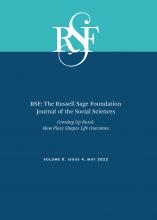Research Article
Open Access
Do Federal Place-Based Policies Improve Economic Opportunity in Rural Communities?
Emily Parker, Laura Tach, Cassandra Robertson
RSF: The Russell Sage Foundation Journal of the Social Sciences May 2022, 8 (4) 125-154; DOI: https://doi.org/10.7758/RSF.2022.8.4.06
Emily Parker
aPostdoctoral fellow with the Population Studies Center at the University of Michigan, United States
Laura Tach
bAssociate professor of sociology and public policy at Cornell University, United States
Cassandra Robertson
cSenior policy and research manager at New America, United States

REFERENCES
- ↵
- Alderman, Derek H., and
- Robert N. Brown
- ↵
- ↵
- Austin, Benjamin,
- Lawrence Summers, and
- Edward Glaeser
- ↵
- Baldwin, Sidney
- ↵
- Billings, Dwight B
- ↵
- Braga, Anthony A.,
- David M. Kennedy,
- Elin J. Waring, and
- Anne Morrison Piehl
- ↵
- Breathitt, Edward T
- ↵
- Brenner, Neil,
- Peter Marcuse, and
- Margit Mayer
- ↵
- Bullard, Robert D
- ↵
- ↵
- ↵
- ↵
- Cho, Clare
- ↵
- Cisneros, Henry G., and
- Lora Engdahl
- ↵
- ↵
- ↵
- Dewees, Sarah,
- Linda Lobao, and
- Louis E. Swanson
- ↵
- Domina, Thurston
- ↵
- ↵
- ↵
- Economic Research Service
- ↵
- Estrada, Joselito K., and
- Albert J. Allen
- ↵
- Fischer, Claude S., and
- Greggor Mattson
- ↵
- Foulkes, Matt, and
- Kai A. Schafft
- ↵
- Francis, Robert D
- ↵
- ↵
- Freeman, Lance
- ↵
- ↵
- Glaeser, Edward L., and
- Joshua D. Gottlieb
- ↵
- Hall, Robert, and
- Carol Stack
- ↵
- ↵
- ↵
- Kefalas, Maria, and
- Patrick Carr
- ↵
- ↵
- Krause, Eleanor, and
- Richard V. Reeves
- ↵
- ↵
- Lichter, Daniel T., and
- Kenneth M. Johnson
- ↵
- Logan, John,
- Zengwang Xu, and
- Brian Stultz
- ↵
- Marcuse, Peter
- ↵
- Massey, Douglas S., and
- Nancy A. Denton
- ↵
- Neumark, David, and
- Helen Simpson
- ↵
- Niccolai, Ashley R.,
- Sarah Damaske, and
- Jason Park
- ↵
- Orszag, Peter R.,
- Melody Barnes,
- Adolfo Carrion, and
- Lawrence Summers
- ↵
- Parsons, Ryan
- ↵
- ↵
- ↵
- Rothstein, Richard
- ↵
- Scally, Corianne, and
- Lily Posey
- ↵
- Shambaugh, Jay, and
- Ryan Nunn
- ↵
- ↵
- Sherman, Jennifer, and
- Kai A. Schafft
- ↵
- Squires, Gregory D
- ↵
- ↵
- Tach, Laura,
- Alexandra C. Cooperstock,
- Samuel Dodini, and
- Emily Parker
- ↵
- ↵
- ↵
- Tickamyer, Ann R., and
- Cynthia M. Duncan
- ↵
- ↵
- ↵
- ↵
- Wiley, Keith
In this issue
Do Federal Place-Based Policies Improve Economic Opportunity in Rural Communities?
Emily Parker, Laura Tach, Cassandra Robertson
RSF: The Russell Sage Foundation Journal of the Social Sciences May 2022, 8 (4) 125-154; DOI: 10.7758/RSF.2022.8.4.06
Jump to section
Related Articles
- No related articles found.
Cited By...
- No citing articles found.





